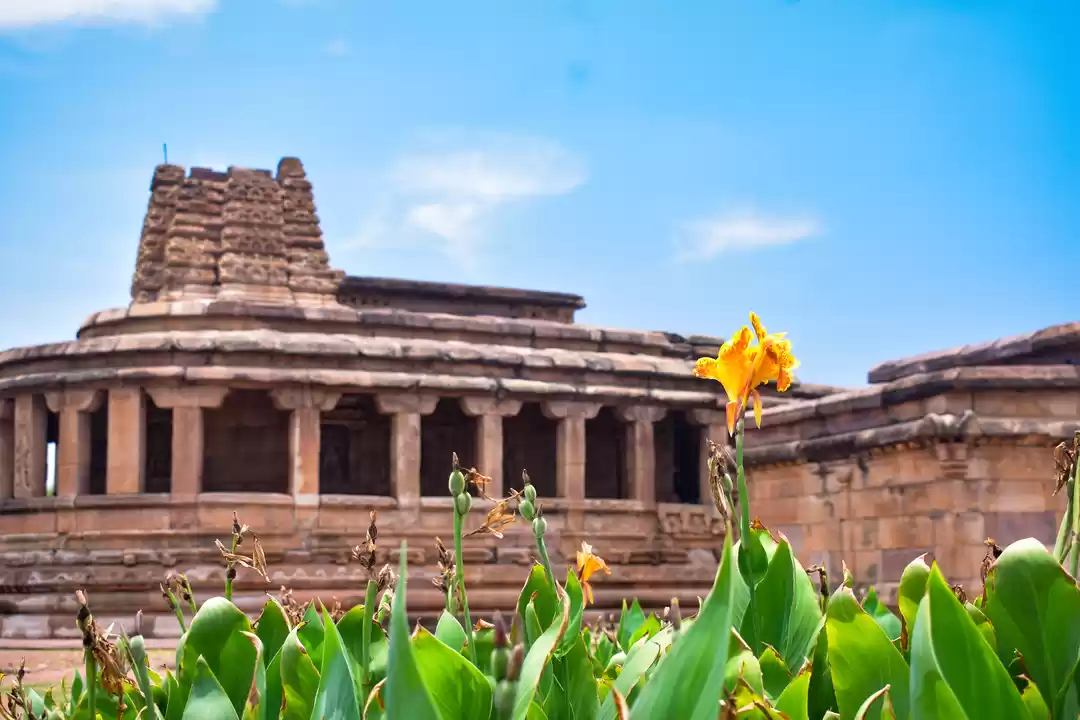Sage Agasthya once, after a meal served by 2 brothers , proclaimed "Vathapi Jeerano".. The demon vathapi, who had posed as a Brother and entered to kill the sage instead was destroyed in the sage's digesting power. The other brother was killed by the ganga water from the sage's kamandala
That the sage Agasthya was able to digest the meal, but our eyes dont digest the feast that the architecture of the area provides. It is beyond our digesting capability and need our cameras to chew on the cud based on the camera snaps
Welcome to Badami- Vathapi as per our mythology

Badami, was a capital of the Chalukyan Dynasty who ruled the North Karnataka Part. Like any other dynasties, they were also very fond of Art & Architecture. And the Arch Rivals of the Chalukyas was the Pallavan empire that ruled the Tamilnadu region. The Pallavans too had their own styles of Architecture & Sculpturing
The Chalukyan dynasty, prone to invasions, wanted to establish a Fort in defence at Badami. The region of Badami is surrounded by various Hillocks which had naturally formed small caves in the rocks on the hillocks. The Chalukyas were fascinated by the Rock-cut temples of the Pallava at Mahabalipuram and decided to engrave their fort with similar architecture. Thus was born the Sculptures filled Rock-cut temples of Badami


The Hillock had 4 caves in ascent of the Hill which the Kings wanted to adorn. For the purpose, they chose each of the cave to be dedicated to a particular God, based on the various Gods who were worshipped at that time.
Cave 1: Sculptures dedicated to Lord shiva and various forms
Cave 2: Sculptures dedicated to Lord Vishnu and various forms
Cave 3 : Sculptures related to Jainism
Cave 4: Sculptures dedicated to Buddhism
The caves come in an ascent over the hill, starting with Cave 1 as we enter and ending with cave 5 at the last. A few unused caves too are found on the way, which even today are not very easy to climb and are slippery at places.
A flight of stairs proceed seperately to our right as we proceed which halts at a closed door. The stairs arent a easy climb and the very few steps which are being allowed present a tough climb with a high raise between the stairs. This stairs was perhaps to prevent the enemy from having a very easy access to ascend at the time of war

The structure is not only an architectural marvel, but the basis at which it has been way display the engineering talents too of the workers employed at that time in creation of this place. The rocks have been cut, but delicate working and proper pillar supportings have been provided with the correct stents to ensure that the rocks stay in place and in turn provide a proper look to the structure. To ensure no pillar is plain and boring, each of these pillars support have a seperate arhcitecture as it supports the domes.

As we proceed up the hillock, a pond comes int our view at far below, at the end of which is a small temple dedicdated to Lord Boothnath, an incarnation of Lord Shiva. This was supossed to be place, where Sage Agastya worshipped Lord shiva after slaying the demons of Vaathapi and Ilava.
As per mythology, Vathapi and Ilava were 2 demons who lived in the caves of Vathapi- Badami. They used to disguise as brothers and invite sage passing through the area to a meal. While Ilava used to serve the meal, Vathapu would enter into disguise in the food so consumed by the sages. After food, Ilava used to call on his brother Vathapi, and Vathapi used to come out of sage's body on hearing brother's call, in turn killing them. Then both demons used to consume on the humans
One day, as both awaited for their meal, Sage agastya came across to the Town. The demons were overjoyed and did their usual tatics. Just as Sage Agastya finished his feast, he announced "Vathapi Jeerano". The same moment, Vaathapi drowned inside the feast that was served and was slayed. Ilava, realiisng his brother not respnding to his call , tries to flee but was slayed by the water from the Holy can held by the sage. Later, as a penance for killing, Sage agastya worshipped Lord shiva to free him from the sins and later proceeded on his journey

The Cave Temples are open for visitors from morning 9:30AM to evening 5:30PM and are closed for visitors on tuesdays. The place is undertaken by Archaelogical Survey of India and they charge a nominal fee of Rs.10/- per visitor
Badami is located in the Bagalkot District of North Karnataka. It is situated at about an distance of 450 km from the State capital City of Bangalore and about 80 kms from Hubli. Strategically located on the Bagalkot-Gadag State highway, the Town is majorly a tourist centre
The Temple of Banashankari, dedicated to Goddess Parvathi is located about 5 kms from this Town
The options for accommodation and food are few. A accommodation cum restaurant is run by KSTDC inside the town offering food and accommodation
How to Reach:
Train No. 16535/36 Mysore Solapur Golgumbaz Express connects Badami to Bangalore and Mysore everyday. The train leaves Mysore at 4PM, Bangalore City at 7PM and reach Badami at 6:30AM the next morning. In return direction, the train leaves Badami at 7:00PM and reaches Bangalore at 8AM the next day
Deluxe bus services available from Bangalore to Bagalkot on regular basis. Regular Express buses operated by NWKRTC run from Hubli and Bagalkot to Badami
Monsoons and Winters are best time to visit the cave temples. Winters afternoons could be hotter so its better to complete the visit in day time and take rest in afternoons as the area is completely open

























